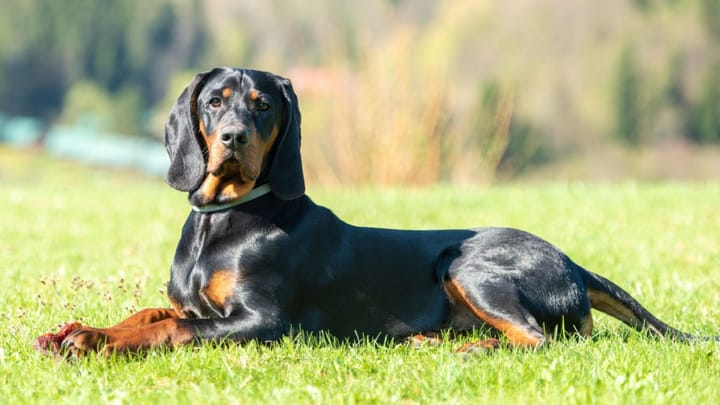Polish Hunting Dog
Other name: Gonczy polski

The Polish Hunting dog is a versatile hunting dog that can be used for hunting deer, as well as hare, fox or wild board. Balanced, gentle and courageous, they are an intelligent and docile breed that can even make good guard dogs.
|
Life expectancy |
The Polish Hunting Dog has a life expectancy of between 12 and 15 years |
|
Temperament |
|
|
Size |
Medium
|
|
Adult size |
Female
Between 20 and 22 in
Male
Between 22 and 23 in
|
|
Adult weight |
Female
Between 44 and 66 lb
Male
Between 44 and 66 lb
|
|
Coat colour
They can be black and light, brown and light or red with a black, brown or flesh-coloured nose. |
Black Brown Red |
|
Type of coat
Their hair is short. The hair is coarse and lies on the body with an abundant overcoat, especially in the winter. The hair is softer on the head. |
Short Hard |
|
Eye colour
Eyes are dark in black and light dogs and lighter in brown and red dogs. |
Brown
|
In some countries, the Polish Hunting Dog is used by the police, notably due to their phenomenal sense of smell and their unheard-of sense of direction (utility searching, searching for narcotics etc.)
More details about the Polish Hunting Dog
Polish Hunting Dog: Origins and history
The history of the Polish Hunting Dog dates back to the 13th century. In Poland, hunting dogs were particularly appreciated, especially by Noblemen as evidenced in chronicles dating from the 14th century. From the 16th century, two Polish breeds stood out: the Polish Brachet (heavier)and the Polish Hunting Dog (lighter) as described on this page. The dog lover Jozef Pawuslewicz that develops the breeding and writes their standard, which will then allow the Cynological Association of Poland to officially recognise the breed.
Physical characteristics of the Polish Hunting Dog
The Polish Hunting Dog is a medium-size breed, flexible and of a stocky build. Their head is noble, their skull slightly bulging and the stop a little marked. The eyes are of a medium size, slanted and express a certain sweetness. Triangular in shape, their ears are medium in size and drooping. The tail, average length, is covered with fur and hangs fairly low, in saber and slightly exceeds the dog’s back when they are in action.
FCI classification of the Polish Hunting Dog
-
Group 6 - Scent hounds and related breeds
-
Section 1 : Scent hounds
Polish Hunting Dog: Characteristics
Polish Hunting Dog: Behaviour
Training a Polish Hunting Dog
Particularly docile, the Polish Hunting Dog, is very easy to train as they feel the need to satisfy their owners.
Sometimes stubborn, like any hunting dog, good training must therefore begin as soon as the Polish Hunting puppy arrives at their adopted home.
The educational bases should be acquired smoothly and in a positive way.
Recall will be advantageous in order to keep a check on this dog, especially during walks.
Polish Hunting Dog: Lifestyle
Breed compatibility Polish Hunting Dog
Polish Hunting Dog: Purchase price
The price of a Polish Hunting Dog varies according to their origin, age and sex of the dog. We do not have enough data to set an average price for this dog breed.
Regarding the average budget to meet the needs of a dog this size, it costs approximately £35 a month.
Polish Hunting Dog: Shedding
Average
Hair loss is only moderate but intensifies during moulting as the undercoat thins down in the summer. Brushing the coat daily is suggested during these periods.
Polish Hunting Dog: Grooming
Maintaining this short-haired dog is not particularly difficult but still requires weekly attention to ensure the beauty and protective qualities of their coat are preserved.
Their dangling ears are also to be monitored and cleaned regularly in order to prevent infection.
Polish Hunting Dog: Health
The life expectancy of this breed is estimated at 13 years.
They are a very strong breed who do not fear much and can work on any terrain and in any weather conditions.
This dog isn’t particularly afraid of the heat, but it’s still essential to spare them from any excessive temperatures, especially as their determination for work will not waver in any condition.
Their dense undercoat, which thickens when winter approaches, gives them good protection against bad weather.
These active dogs are not subject to being overweight. If it is the case that their weight is not stable, their physical exertion should be seriously considered.
The Polish Running Dog is resistant and does not suffer from any particular hereditary diseases. Beware, however, of the risk of ear infection, which is often seen in dogs with dangling ears.

